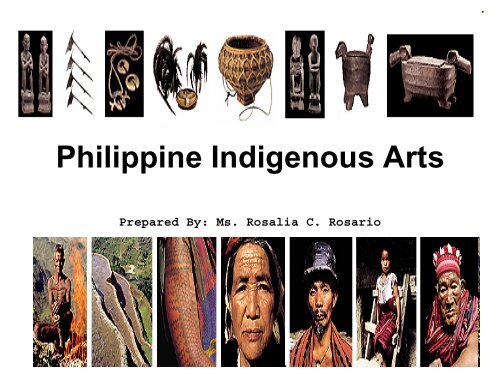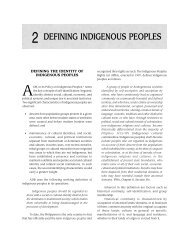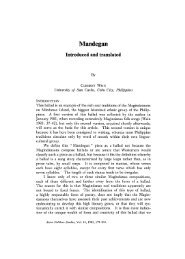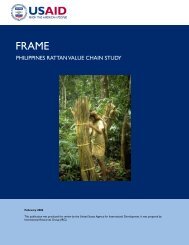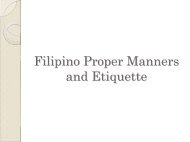Philippine Indigenous Arts - Philippine Culture
Philippine Indigenous Arts - Philippine Culture
Philippine Indigenous Arts - Philippine Culture
You also want an ePaper? Increase the reach of your titles
YUMPU automatically turns print PDFs into web optimized ePapers that Google loves.
<strong>Philippine</strong> <strong>Indigenous</strong> <strong>Arts</strong><br />
Prepared By: Ms. Rosalia C. Rosario
Ancient and pre-Spanish Era:<br />
It is believed that the first inhabitants of the <strong>Philippine</strong>s arrived<br />
over many thousands of years ago. It is commonly thought that<br />
they migrated over a land bridge, which existed at that time, from<br />
the Asian mainland.<br />
The next known inhabitation is when the Negrito or Aeta arrived<br />
in the islands. However, they were driven back by several waves<br />
of immigrants from Indonesia, only to be followed by the maritime<br />
peoples of the Malayan islands.
<strong>Philippine</strong> <strong>Indigenous</strong> <strong>Arts</strong><br />
• Sculpture /Carving<br />
• Pottery<br />
• Weaving<br />
• Physical ornaments
Sculpture is three-dimensional artwork created by<br />
shaping or combining hard materials, typically<br />
stone such as marble, metal, glass, or wood, or<br />
plastic materials such as clay, textiles, polymers<br />
and softer metals.
Carving is one of the techniques used in<br />
sculpture.
• Bul-ul are carved Anito<br />
figures of the Ifugaos:<br />
these represent their<br />
ancestral spirit and<br />
granary gods.<br />
• SEATED IFUGAO<br />
"BULUL" AT THE<br />
CONCLUSION OF<br />
THE ANNUAL IFUGAO<br />
HARVEST RITUAL<br />
"BULULS" PLACED IN<br />
RICE GRANARIES ARE<br />
CONSIDERED<br />
GUARDIANS OF<br />
THE HARVEST
Ifugao sculpture
Sarimanok<br />
Shown above are the most well-known of the old designs, the sarimanok. The<br />
figure represents a fowl with wings, feathered tail, and a head decorated with<br />
ornaments of scrolled and painted motif of leaves, spirals, and feather-like<br />
forms. It usually stands on a fish and another one hangs from its beak. The<br />
wooden figure, usually perched atop a bamboo pole, stands among<br />
decorative flags during weddings and other festive occasions.
Ang Hagabi ay isang upuang kahoy ng mga Ifugao na sumisimbolo<br />
sa panlipunang katayuan ng isang mamamayan. Ito ay nagpapakita<br />
ng yaman at kapangyarihan ng may-ari nito na kadalasan ay isang<br />
Kadanagyan o isang taong nabibilang sa mataas na antas sa<br />
lipunan. Ito ay sa kadahilanang tanging ang mga mayayaman<br />
lamang ang may kakayahang mag pagawa nito kasama na ang ritwal<br />
na ipinagdiriwang sa oras na matapos ang pagbubuo nito.
Ang hagabi ay isang upuang kahoy na gawa sa narra o ipil. Ang orihinal<br />
na anyo nito ay tinatawag na ginulgulding na ang ibig sabihin ay "kagaya<br />
ng kambing", sapagkat sa dalawang dulo ng upuan ay mayroong nakaukit<br />
na animo'y ulo ng kambing. Sa kasalukuyan ang hagabi ay may iba't iba<br />
nang anyo - ang isang dulo nito na tinatawag na ngiwi ay kagaya na ng<br />
ulo ng isang hayop na may mahabang ilong at dalawang malalaking<br />
tainga.
Torogan, the ancestral home of the<br />
Maranao Sultan or Datu.<br />
• One of the richest<br />
survivors of <strong>Philippine</strong><br />
pre-Spanish art is<br />
Maranao decorative art,<br />
described by critics as<br />
graceful and<br />
rhythmical.The<br />
floorbeams of the<br />
houses project beyond<br />
the walls, and the ends<br />
or panolong, such as<br />
the decorative figure,<br />
are carved and<br />
multicolored.
The Panolong is a carved end<br />
beam of the Torogon.
Pottery are objects that are first shaped of wet<br />
clay, then hardened by baking. Pottery includes<br />
both decorative and practical items such as<br />
bowls, vases, dishes, and lamps
Pottery in the <strong>Philippine</strong>s varies in forms and<br />
functions. The forms of the pots are directly<br />
influenced by the functions of the pots and the<br />
tradition of the community/local area.
Palayok
Manunggul Jar<br />
Ang Tapayan sa Manunggul ay isang banga na ginamit sa paglilibing ng<br />
mga sinaunang tao sa Palawan noong 890-710 BK. Ang banga ay ukol sa<br />
sekondaryang paglilibing kaya mga buto lamang ng yumao ang laman nito.<br />
Itinuturing itong Pambansang Kayamanan ng Pilipinas at makikita rin sa<br />
likod ng 1000 libo na salapi.
Manunggul Jar
• The Manunggul Jar is a<br />
National Treasure of the<br />
<strong>Philippine</strong>s. A secondary<br />
burial jar, it is designated<br />
item 64-MO-74 in the<br />
National Museum of the<br />
<strong>Philippine</strong>s, Manila. The<br />
jar was found in Chamber<br />
A of the Tabon Cave, one<br />
of the Manunggul caves<br />
in Palawan. The jar is<br />
dated from about 2800<br />
years before the present.<br />
It was found by Robert<br />
Fox and Miguel Santiago.
Leta-leta cave archaeology<br />
Leta-leta Cave, Langen Island,<br />
El Nido, Palawan was<br />
excavated in 1965 by Dr.<br />
Robert Fox. Leta-leta Cave is<br />
an important burial site<br />
belonging to the Late<br />
Neolithic Period where an<br />
assemblage of stone and<br />
shell artifacts associated<br />
with sophisticated pottery<br />
and nephrite adzes and axes<br />
were recovered. Other<br />
materials include stone<br />
ornaments and shell beads.
Weaving means to make cloth and other<br />
objects. Threads or strands of material<br />
are passed under and over each other.
Weaving in the <strong>Philippine</strong>s has different forms, functions<br />
and materials. They also vary in design and techniques<br />
used. Most of the common forms of weaving in the<br />
<strong>Philippine</strong>s are in the form of hats, mats, bags, baskets<br />
and textiles (clothes and blankets).
Weaving
A malong bearing okir designs.<br />
The Maranaos call their ornamental design okir, a<br />
general term for both the scroll and the geometric form.
Okir Design<br />
•Okir a datu (gentlemen’s design) The scroll is the<br />
dominant feature in the men’s work composed of<br />
various spiral forms. In contrasts, the zigzag and<br />
angular forms are the dominating motifs in women’s<br />
geometric art – okir a bay (ladies’ design).
•The most popular of all the malong styles is the landap. Which is<br />
either dominantly red, yellow, green, blue, or violet. Red is the<br />
favorite color along with yellow; these colors stand for royalty or<br />
aristocracy. Often, men wear the red landap and the women, the<br />
yellow.
Physical Ornaments<br />
BONTOC, IFUAGO, AND KALINGA TRIBAL TEXTILES<br />
WITH A VARIETY OF SILVER AND BRASS<br />
"LINGLINGO" FERTILITY CHARMS
BONTOC WARRIOR'S RITUAL "BOAYA" HEAD HUNTING NECKLACE: SHELL,<br />
BOAR TUSK, RATTAN, FIBERAND BONE<br />
Physical ornamentation can be categorized to three areas specifically<br />
the use of traditional costumes (textile), jewelries and tattoos. The<br />
designs vary depending on the location, users and function of the<br />
ornaments.
Filipino bawisak earrings<br />
• Traditional Ifugao tribe<br />
(Northern Luzon,<br />
<strong>Philippine</strong>s) bead and<br />
shell bawisak earrings.<br />
The bottom shell designs<br />
have been described as<br />
either representing<br />
butterflies<br />
or a certain item of male<br />
generative anatomy.
IFUGAO: WARRIOR'S<br />
SILVER "LINGLINGO"<br />
EARRING PAIR AND PENDANTS
Traditional Filipino Tattoo
The <strong>Philippine</strong> Tribal Costumes<br />
The B'laan are one of the indigenous peoples of Southern Mindanao in<br />
The <strong>Philippine</strong>s.<br />
They are famous for their brassworks, beadwork and t'nalak weave.<br />
The people of these tribes wear colorful embroidered native costumes<br />
and beadwork accessories.
KALINGA<br />
• The Kalinga are called the<br />
“peacocks of the north”<br />
because of their attention to<br />
appearance and dressing.<br />
Kalinga is a landlocked<br />
province of northern<br />
Cordillera, <strong>Philippine</strong>s.<br />
“Kalinga” means enemy, a<br />
name that the bordering<br />
inhabitants<br />
called this tribe because of<br />
their headhunting attacks.<br />
The name stuck and became<br />
accepted by the natives<br />
themselves.
T'BOLI<br />
• The T'boli distinguish<br />
themselves from other<br />
Tribal Groups<br />
by their colorful<br />
clothes, bracelets and<br />
earrings,<br />
this tribe is famous for<br />
their complicated<br />
beadwork,<br />
wonderful woven<br />
fabrics and beautiful<br />
brass ornaments.
The Bagobo are proud people with proto Malayan features.<br />
They have ornate traditions in weaponry and other metal arts.<br />
They are noted for their skill in producing brass articles through the ancient lostwax<br />
process.<br />
These people also weave abacca cloths of earth tones and make baskets<br />
that are trimmed with beads, fibers and horse's hair.
How does <strong>Philippine</strong> folk<br />
(indigenous) art reflect nature<br />
and the life of the common folk?<br />
• <strong>Philippine</strong> folk (indigenous) art reflects<br />
nature and the life of the common folk<br />
through various media techniques and<br />
processes based on the factors of time,<br />
climate, resources, ideas and historical<br />
and cultural context
References:<br />
• www.google.com<br />
• www.yahoo.com<br />
• yandanholth.com/philcostume.html<br />
•:www.urduja.com/tattoo/dosayan.html<br />
•:www.organicjewelry.com/ethnicSold.html


